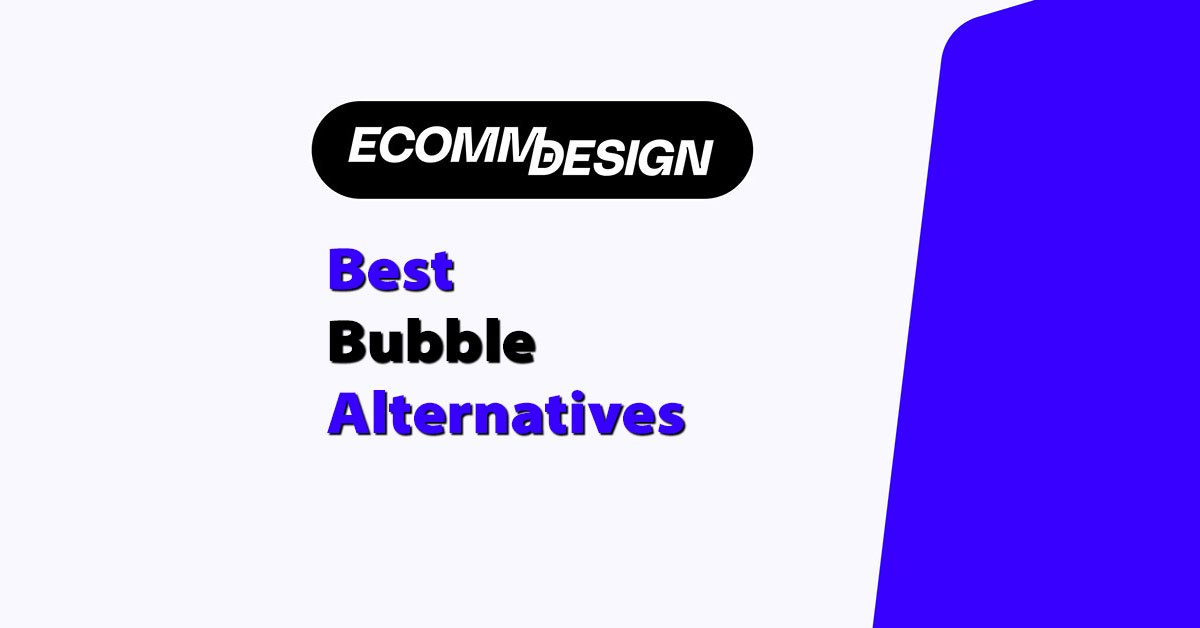
Quick answer:
The best Bubble alternatives for ecommerce are Webflow, Shopify (especially with Hydrogen), and Builder.io. These platforms let you launch fast, scale easily, and design with far fewer limitations.
I’ve built ecommerce sites on everything from Shopify to custom headless stacks.
And while Bubble’s a beast in flexibility, it’s not always the right fit—especially for ecommerce. It’s powerful, but with power comes complexity. You want a store, not a software dev project.
So if you’ve been burned by Bubble’s slow performance, clunky checkout flows, or the constant need to plug in workarounds, here are the top platforms worth your time (and money).
Bubble Alternatives Comparison Table (For Ecommerce)
| Platform | Best For | Ecommerce Ready | Design Control | Price Range (USD/month) | Technical Skill Needed |
|---|---|---|---|---|---|
| Shopify + Hydrogen | Scalable ecommerce with dev support | ✅✅ Enterprise | ⭐⭐⭐⭐ | $39–$399 (plus dev cost) | High |
| Framer | One-product or prelaunch pages | ⚠️ Limited | ⭐⭐⭐⭐ | Free–$30 | Low |
| Webflow | Design-driven stores | ✅ Yes | ⭐⭐⭐⭐⭐ | $29–$212 | Medium |
| Adalo | Mobile-first stores and MVPs | ✅ Yes (Mobile) | ⭐⭐ | $45–$250 | Low |
| Thunkable | Mobile ecommerce apps | ✅ Yes (Mobile) | ⭐⭐ | $13–$167 | Medium |
| Glide | MVPs and digital products | ⚠️ Limited | ⭐⭐ | Free–$125 | Low |
| Bravo Studio | Designers building native apps | ✅ Yes (Mobile) | ⭐⭐⭐⭐⭐ | Free–Custom | Medium |
| WeWeb | Advanced logic + frontend customization | ⚠️ Needs backend | ⭐⭐⭐⭐ | $29–$89+ | High |
| Builder.io | Headless ecommerce with dev resources | ✅ Yes | ⭐⭐⭐⭐ | $15–$49+ (custom plans) | High |
| Softr | Selling digital goods & memberships | ⚠️ Limited | ⭐⭐ | Free–$167 | Low |
1. Shopify + Shopify Hydrogen
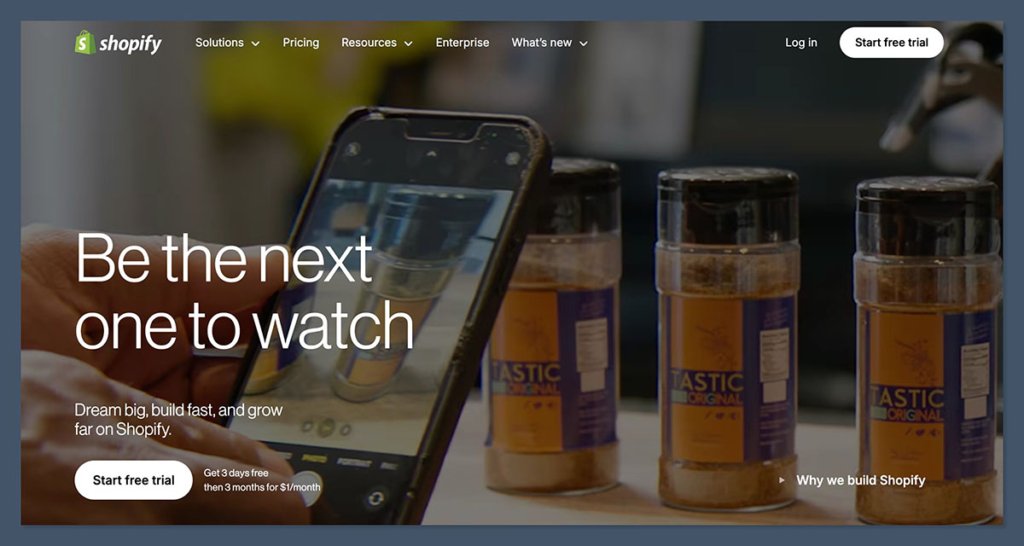
Shopify is the default for ecommerce, but Hydrogen is what makes it a real Bubble alternative.
Most people know Shopify for its plug-and-play simplicity.
But when you layer in Hydrogen, Shopify’s headless framework, you get full control over your frontend — without giving up the power of Shopify’s backend.
It’s what serious ecommerce brands use when they’ve outgrown templates but still want scale and stability.
Pros
- Enterprise-level ecommerce capabilities
- Massive app store and ecosystem
- Hydrogen gives you full frontend flexibility
- Great performance and scalability
- Built-in security, checkout, payment integrations
- Support for POS, internationalisation, and omnichannel selling
Cons
- Liquid (Shopify’s templating language) is limiting unless you go headless
- Costs can add up fast with apps and dev help
- Limited design freedom in standard Shopify setup
- Hydrogen setup requires developer resources
- Longer development cycles than no-code tools
Pricing
| Plan | Cost (USD/month) | Features |
|---|---|---|
| Basic Shopify | $39 | Best for new stores or single-product brands |
| Shopify | $105 | For growing stores with more advanced needs |
| Advanced Shopify | $399 | Lower fees, better reporting, and large-scale tools |
| Shopify Plus | Custom | Enterprise-level features and support |
| Hydrogen Framework | Free | Custom frontend, hosted via Shopify’s Oxygen CDN |
Additional costs to expect:
- Apps from Shopify’s ecosystem (subscriptions can stack quickly)
- Developer time for Hydrogen setup and custom frontend work
- Headless CMS or page builder if going beyond Shopify’s default CMS
Best for
- Brands doing serious revenue who want custom storefronts
- Stores that need complex inventory, checkout, or logistics workflows
- Teams who want power + performance without rebuilding backend logic
- Agencies and dev teams building tailored ecommerce experiences
Why I Recommend It
Hydrogen lets you go fully headless while still using Shopify’s backend. It’s a killer combo if you’re scaling and need speed, customization, and ecommerce best practices baked in.
I’ve used Hydrogen for high-growth DTC brands where the standard Shopify themes just couldn’t keep up.
2. Framer
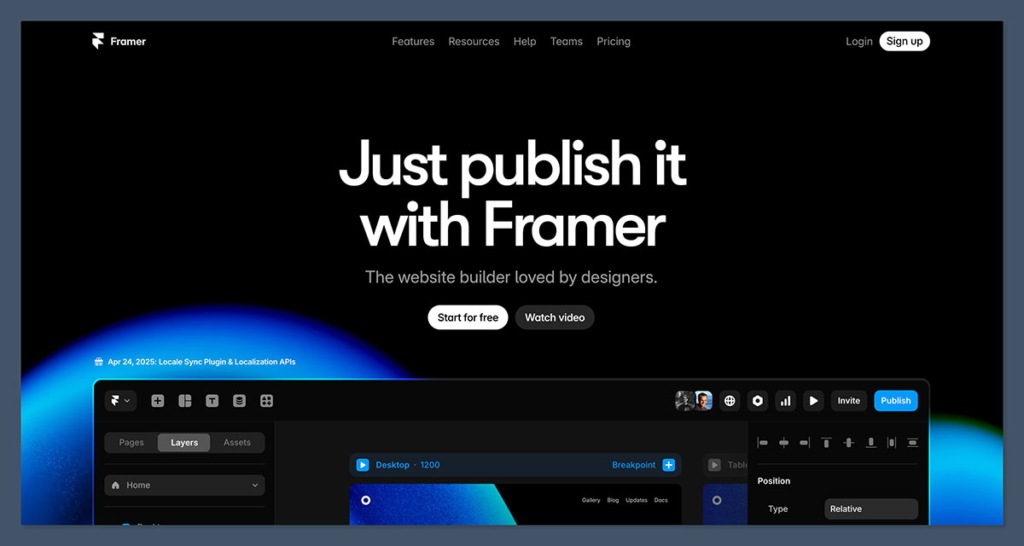
Framer’s like Webflow, but even faster to get started with.
It’s built for speed — you can go from idea to live site in under an hour. The interface is incredibly intuitive, even if you’ve never touched design software before.
And while it’s not built for deep ecommerce logic, it’s a solid choice if you’re launching a single-product store or a landing page that needs to look sharp.
Framer’s strength is simplicity. You’re not fighting with plugins or dealing with clunky templates. You get a blank canvas, clean animations, and instant publishing. It’s visual, fast, and lightweight.
Pros
- Instant publishing, zero setup
- Great for landing pages and single-product stores
- Simple interface, no code needed
- Clean design system and animations
- Modern visual tools built for designers
- Built-in forms, CMS, and custom domains included
Cons
- Ecommerce is still basic (no multi-product or cart flow out of the box)
- Not built for complex data models
- Limited integrations and scalability
- No true backend logic or user workflows
- Payment options require embedding third-party tools like Stripe or Gumroad
Pricing
| Plan | Cost (USD/month) | Features Included |
|---|---|---|
| Free | $0 | 1 site, basic CMS, limited custom domains |
| Pro | $25 | Custom code, password protection, analytics |
| Business | From $30 | Advanced hosting, scaling support |
There are no hidden platform fees, but you’ll still need to integrate with tools like Stripe or Lemon Squeezy if you want to collect payments. That means Framer works more like a frontend-only solution than a full ecommerce platform.
Best for
- One-product stores
- Prelaunch or MVPs
- Designers who want fast execution without tech bottlenecks
- Founders validating product-market fit with minimal effort
- Creators selling digital products or early-stage offers
Why I Recommend It
I’ve used Framer for dropshipping and single-product brands. It shines when speed matters more than backend depth. If you want to validate an idea without touching Shopify, Framer delivers.
3. Webflow
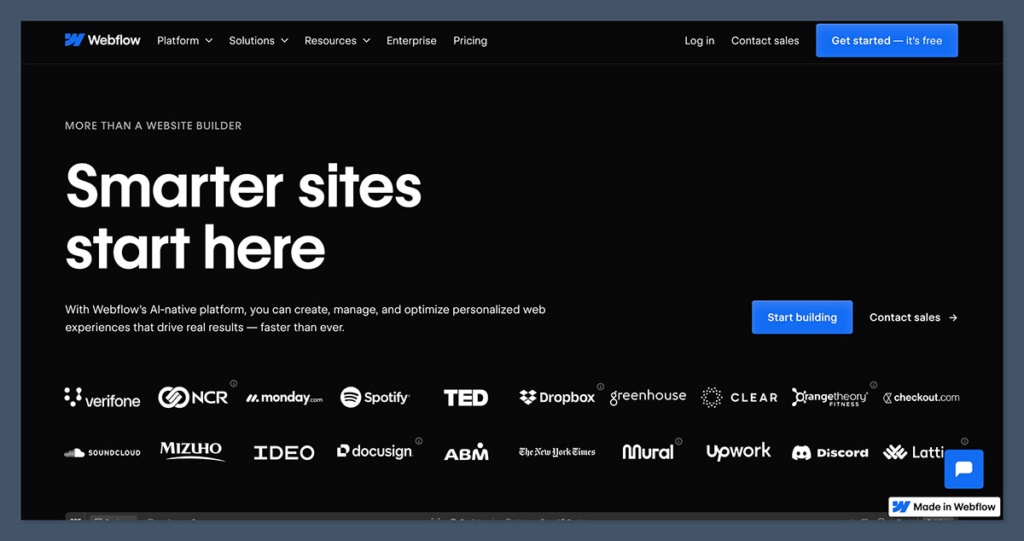
If you care about visual design and frontend control, Webflow is my go-to pick.
You don’t need to know how to code, but you still get pixel-perfect layouts. That makes it ideal for stores where design and brand presence matter. It’s fast, looks great, and doesn’t box you into a theme like most ecommerce platforms.
Pros
- Clean, fast-loading code compared to Bubble
- Full design control without touching code
- CMS and ecommerce built-in
- Works well for landing pages, marketing, and ecommerce products
- Strong SEO capabilities with clean URLs and meta controls
- Real-time preview and visual editor
Cons
- Ecommerce features are limited compared to Shopify
- Can get expensive once you start scaling
- Learning curve for people new to design systems
- No multi-language support built-in (requires workarounds)
- Checkout is not customisable beyond Webflow’s native structure
Pricing
| Plan Type | Cost (USD/month) | Includes |
|---|---|---|
| Website Basic | $14 | Good for landing pages without ecommerce |
| Standard Ecommerce | $29 | Up to 500 items, basic ecommerce features |
| Plus Ecommerce | $74 | For scaling stores, includes cart recovery |
| Advanced Ecommerce | $212 | Full suite, ideal for high-volume stores |
You’ll also pay separately for:
- Hosting (built-in to Webflow’s plans)
- Custom domains
- 3rd-party integrations (Zapier, Make, Memberstack, etc.)
Best for
- Ecommerce stores that care deeply about branding and design
- Small to mid-size stores that don’t need crazy backend logic
- Agencies designing marketing-driven ecommerce experiences
- Teams that want marketing and ecommerce in one place
Why I Recommend It
Webflow gives you speed, control, and clean layouts. You can launch a high-converting site without relying on developers for every change.
I’ve built beautiful storefronts in Webflow that outperformed Shopify stores simply because they looked and loaded better.
4. Adalo
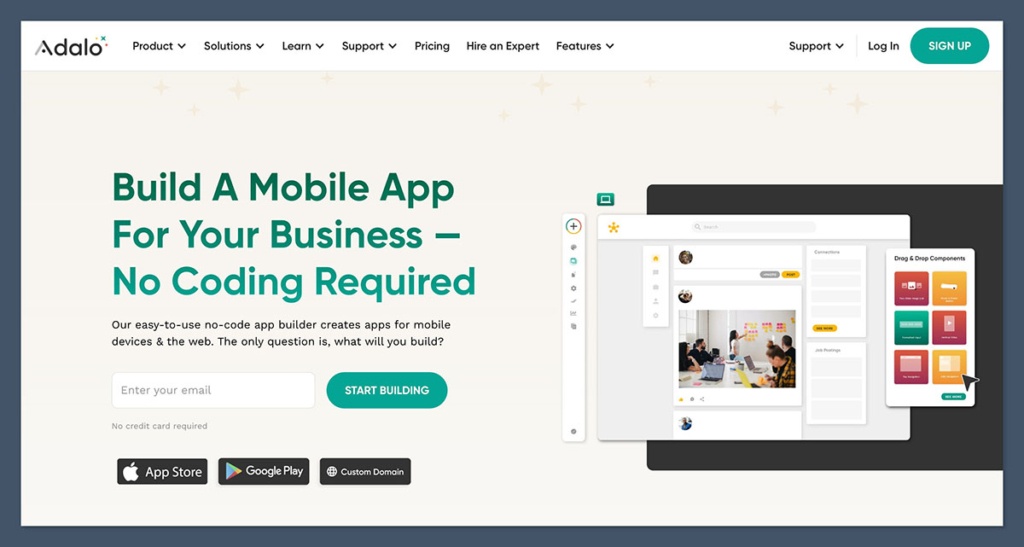
Adalo is solid for mobile-first ecommerce or app-based selling.
It’s not your typical website builder — it’s designed to help you create native mobile apps without writing code. If you’re thinking beyond the browser and want your customers engaging directly through an app, Adalo gives you a simple way to make that happen.
The drag-and-drop interface feels a lot like Canva meets app development.
You don’t need to know a thing about Swift, React Native, or APIs. And yet you can build full ecommerce flows: product pages, carts, payments, user accounts — all native, all mobile-first.
Pros
- Native mobile app builder with visual interface
- Drag-and-drop layout, no code needed
- Built-in payments with Stripe
- In-app navigation, user login, and database functions
- Fast MVP development for mobile use cases
- Push notifications, dynamic content, and conditional logic built in
Cons
- Not built for large-scale web stores
- UX is mobile-first, which can feel limiting on desktop
- Scaling performance is hit-or-miss depending on app size
- Less ideal for desktop-heavy brands or SEO-driven traffic
- Custom logic and API integrations require some technical knowledge
Pricing
| Plan | Cost (USD/month) | Features Included |
|---|---|---|
| Free | $0 | Unlimited apps, basic features, no custom domain |
| Starter | $45 | Custom domains, basic logic, and publishing rights |
| Professional | $65 | Database records, external collections, more logic |
| Team & Business | $200+ | White-labelling, collaboration, priority support |
There are also optional costs for app store publishing and third-party tools like Zapier if you want to connect with external services.
Best for
- Mobile-first ecommerce ideas
- Subscription boxes with app components
- Low-tech founders launching MVPs
- Digital product marketplaces or service booking apps
- Creators who want a mobile storefront instead of a traditional site
Why I Recommend It
Adalo is more of an app builder than a site builder. I’ve worked with brands that wanted their store as an app, and Adalo made it happen.
One food subscription startup I helped had this exact goal: they didn’t want a website — they wanted customers ordering, managing subscriptions, and chatting with support all through an app.
5. Thunkable
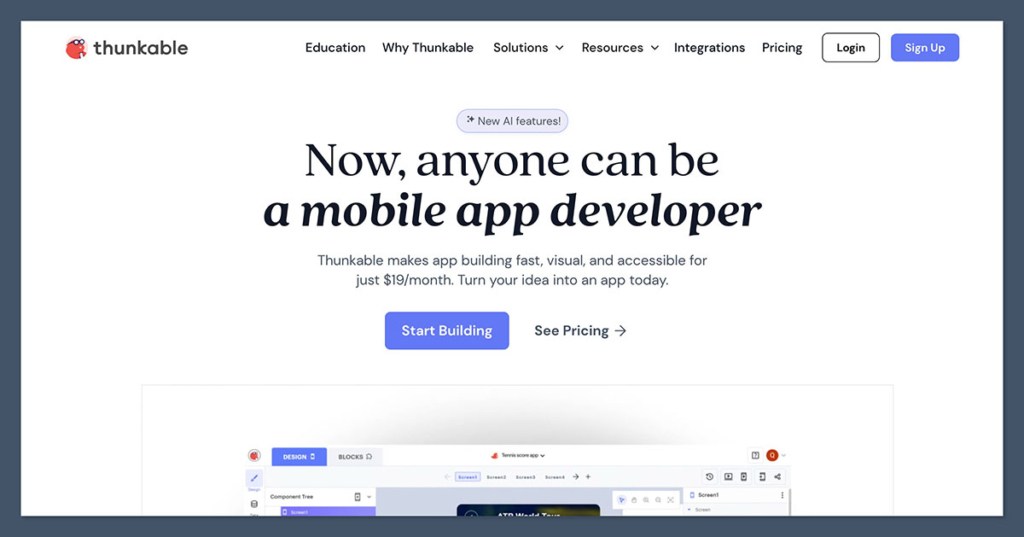
Thunkable is another mobile-focused platform that’s surprisingly good for niche ecommerce.
It’s built for creating mobile apps that run on both iOS and Android without writing code. The builder is visual, modular, and flexible enough to support everything from in-app purchases to custom API integrations.
It’s not a traditional ecommerce platform — but that’s exactly why it stands out in specific use cases.
If your store is more like an interactive app than a standard site — think fitness programs, booking flows, digital tools, or productised services — Thunkable gives you control without needing to hire a mobile dev team.
Pros
- Drag-and-drop app building across iOS and Android
- Native support for Stripe payments and API connections
- Real-time previews and testing on mobile devices
- Powerful component library with logic and navigation flows
- Access to device features like GPS, camera, and notifications
- Ideal for interactive ecommerce concepts (not just storefronts)
Cons
- Not a web store builder (mobile-only interface)
- UI limitations without using custom components or deeper styling
- Limited out-of-the-box ecommerce templates or plug-ins
- Requires manual setup for checkout and product handling
- Learning curve for managing advanced logic and databases
Pricing
| Plan | Cost (USD/month) | Features Included |
|---|---|---|
| Free | $0 | Limited public projects, no app store publishing |
| Starter | $13 | Publish to web and mobile, basic components |
| Pro | $38 | More screens, API access, private projects |
| Business | $167 | Enterprise support, advanced features, team access |
Publishing to the App Store and Google Play is supported in all paid plans, but you’ll need developer accounts on both platforms (Apple and Google), which come with additional fees.
Best for
- App-based ecommerce ideas
- Productised services or niche apps
- Founders testing mobile store concepts
- Coaches, fitness brands, or educational tools
- Teams selling access to content, features, or subscriptions
Why I Recommend It
Thunkable isn’t a Shopify killer, but that’s not the goal. It gives you full control over how users interact with your brand inside a mobile experience.
6. Glide
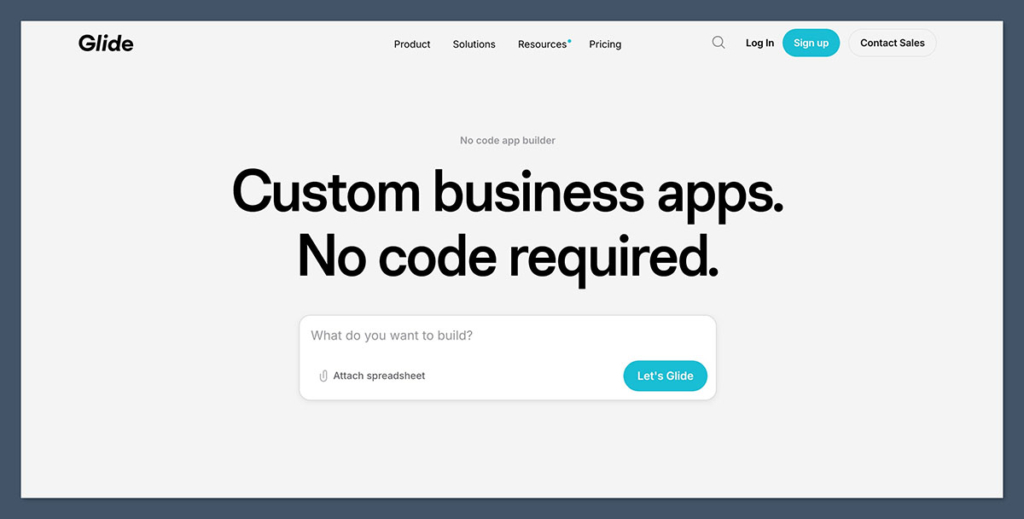
Glide turns Google Sheets into apps. Sounds weird, but it’s shockingly useful.
If you’re looking to launch a basic ecommerce or product catalog without dealing with databases, hosting, or custom development, Glide is one of the fastest ways to do it. You build the app visually, connect it to a spreadsheet, and publish it instantly to the web or as a progressive web app (PWA).
It’s not built for scale, and it won’t handle complex ecommerce workflows. But if you want something live today — and your data already lives in Google Sheets — Glide delivers.
Pros
- Fast MVPs built from spreadsheets
- Good for directories, small product catalogs, or forms
- Zero dev experience needed
- Mobile and desktop-friendly apps
- Built-in support for Stripe payments
- Easy to update content by simply editing the spreadsheet
Cons
- Limited design flexibility
- Not meant for traditional ecommerce flows (cart, checkout, inventory)
- Database limitations if you scale beyond a few thousand rows
- No native SEO or advanced frontend customisation
- Heavily reliant on Google Sheets or Airtable as backend
Pricing
| Plan | Cost (USD/month) | Features Included |
|---|---|---|
| Free | $0 | Up to 500 rows, Glide branding, limited features |
| Starter | $60 | Custom branding, more rows, public apps |
| Business | $125 | Private user access, custom domains, larger databases |
| Enterprise | Custom pricing | SSO, team features, integrations with BigQuery or SQL |
If you’re working with clients or need to build internal tools for ecommerce teams — like order tracking dashboards or inventory lists — Glide’s pricing is reasonable given the development time it saves.
Best for
- Side hustles or mini ecommerce apps
- Internal tools or client order systems
- Creators selling digital goods
- Teams building admin panels, simple B2B tools, or portals
- Non-technical founders looking to validate a product
Why I Recommend It
It’s not built for high-traffic stores or complex workflows. But for MVPs, digital products, or simple order forms, Glide gives you speed and simplicity that’s hard to match.
You can manage inventory, view orders, and even trigger automations through integrations like Zapier or Make.
It’s best when your data is simple and your team is non-technical. For quick launches, internal tools, or basic ecommerce experiments, Glide delivers more than you’d expect from a spreadsheet-powered builder.
7. Bravo Studio
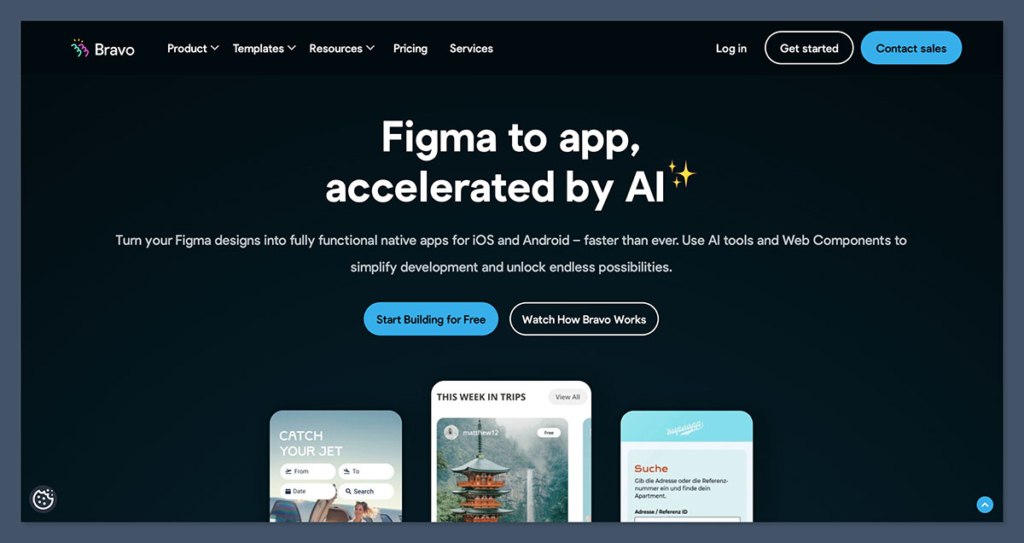
Bravo turns Figma designs into native apps.
It’s built for designers who already live in Figma and want to take that pixel-perfect design and turn it into a real mobile app — without writing code.
With Bravo, you build your screens in Figma, connect them to live data or APIs, and publish a fully functional native app to iOS and Android.
That design-first approach is what makes it stand out. Most no-code tools force you into pre-built components and clunky editors. Bravo keeps the creative process in Figma and handles the build and functionality for you.
Pros
- Full design freedom from Figma
- Native app publishing for iOS and Android
- Built-in support for Stripe, REST APIs, and Airtable
- Animations and transitions fully supported via Figma design tokens
- Real-time preview with Bravo Vision app
- No-code logic: page navigation, form handling, API requests
Cons
- You’ll need solid Figma skills to get the most out of it
- No web version — mobile apps only
- Limited ecommerce templates or pre-built UI kits
- App complexity can grow quickly if you’re not organised
- Data updates require structured backend or 3rd-party tools
Pricing
| Plan | Cost (USD/month) | Features Included |
|---|---|---|
| Free | $0 | Bravo branding, limited features, basic test builds |
| Pro | $19 | Custom branding, advanced integrations, published apps |
| Business | Custom pricing | White-labelling, API support, team workflows, priority access |
You’ll also need to factor in backend tools (like Airtable or Xano) and Apple/Google developer accounts if you’re publishing to app stores.
Best for
- Designers building mobile shopping apps
- Brands with an existing Figma workflow
- MVPs that need native functionality
- Agencies wanting to turn client designs into functional apps
- Creators selling products or services via mobile-first experience
Why I Recommend It
Bravo is not for non-designers. If you’re unfamiliar with Figma, there’s a learning curve. But if design quality matters and you want a native mobile app that reflects your brand down to the pixel, this tool delivers.
It’s ideal for one-product stores, productised services, or any ecommerce concept where mobile is the primary touchpoint. If your target audience lives on their phone and you want full design control, Bravo gets you there without needing a mobile dev team.
8. WeWeb
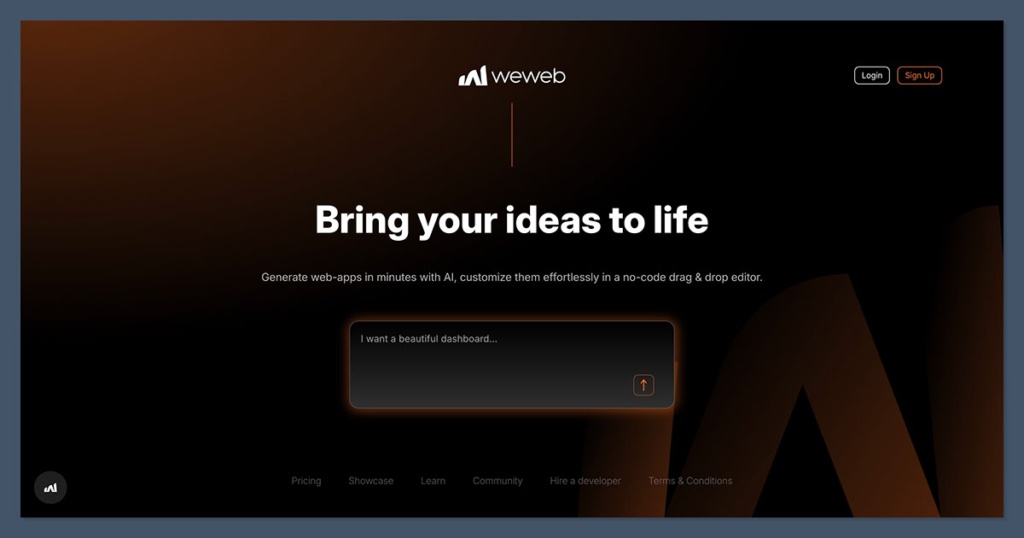
WeWeb is one of the closest no-code web builders to Bubble in terms of power.
It gives you serious frontend flexibility combined with the ability to integrate a custom backend, like Xano, Supabase, or Airtable. That means you’re not limited by pre-built ecommerce logic — you can build exactly what you need.
From gated content to user portals, cart systems to conditional pricing, it’s all possible.
The catch? WeWeb isn’t plug-and-play. You need to be comfortable working with APIs, databases, and connecting logic between frontend and backend.
But if you’re building a complex ecommerce experience or marketplace, this is one of the few tools that won’t hold you back.
Pros
- Great frontend builder with complete visual control
- Easily connects with backends like Xano, Supabase, and Airtable
- Logic and workflows are built visually without traditional code
- Dynamic routing, conditional rendering, and user authentication
- SEO-friendly and built for performance
- Fully responsive with clean HTML and CSS output
Cons
- Not beginner-friendly compared to other no-code tools
- Requires integration with a backend like Xano for full functionality
- Steeper learning curve for non-technical users
- Fewer templates or pre-built ecommerce components
- API rate limits and backend logic management are on you
Pricing
| Plan | Cost (USD/month) | Features Included |
|---|---|---|
| Starter | $29 | 1 project, staging environment, public apps |
| Team | $89 | Unlimited users, role-based access, staging & production |
| Business | Custom pricing | SSO, audit logs, API priority, advanced workflows |
Keep in mind: backend tools like Xano, which you’ll likely pair with WeWeb, also have their own pricing. You’re essentially building a frontend-backend stack, so cost depends on your architecture.
Best for
- Developers or technical founders
- Complex ecommerce needs that go beyond Shopify or Webflow
- Apps that need real user logic and workflows
- Multi-vendor marketplaces, custom pricing systems, or gated content
- SaaS-style ecommerce or subscription logic
Why I Recommend It
I’ve used WeWeb for marketplaces and advanced stores where other platforms couldn’t cut it. If Bubble feels slow but you still want backend power, WeWeb + Xano is a killer combo.
One client needed a vendor marketplace with complex logic: sellers had dashboards, buyers could favourite products, admins had control over commissions and payout timing.
9. Builder.io
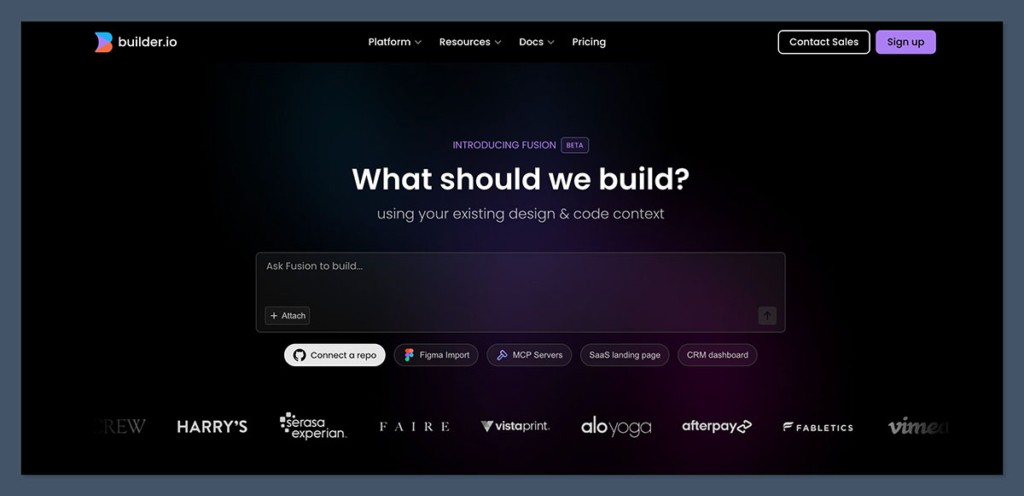
Builder.io is underrated for high-performance ecommerce, especially headless.
It bridges a real gap in the ecommerce stack: marketers and designers want control, but developers want flexibility and performance.
Builder.io sits right in the middle — giving teams a way to visually manage content and layout on top of a custom frontend, while integrating with powerful backends like Shopify, BigCommerce, or even fully custom APIs.
It’s a visual editor layered onto a headless architecture. You still get the performance and flexibility of a custom build — but without needing a dev for every single update.
That makes it one of the few tools that actually scales with your business, instead of slowing you down as you grow.
Pros
- Headless page builder that connects directly to your frontend
- Integrates with Shopify, BigCommerce, Contentful, Sanity, or custom stacks
- Great performance and speed with code-level control
- Drag-and-drop content editing for non-devs
- Works with modern frameworks like React, Next.js, and Vue
- Ideal for marketing teams in developer-driven environments
Cons
- Requires dev setup to implement and maintain
- More complex than Webflow or Framer
- Expensive for enterprise features and collaboration tools
- Not suitable for founders without dev support
- Lacks native ecommerce features (relies on external platforms)
Pricing
| Plan | Cost (USD/month) | Features Included |
|---|---|---|
| Free | $0 | Developer tools, open-source SDK, limited live editing |
| Basic | $15 | Visual editor, simple integrations, content scheduling |
| Growth | $49 | More users, personalization, A/B testing |
| Enterprise | Custom pricing | SSO, team controls, high-traffic optimization, premium SLA |
You’ll also need a separate ecommerce backend (like Shopify or BigCommerce), and possibly a CMS if you’re managing non-product content.
Best for
- Headless Shopify setups
- Teams with a developer onboard
- Brands needing design flexibility with real ecommerce backend
- Content-heavy ecommerce stores
- Fast-scaling brands looking for performance without losing control
Why I Recommend It
For serious ecommerce brands who are scaling fast, Builder.io offers a rare combo: frontend power, backend flexibility, and marketing-friendly workflows. It’s not about skipping code — it’s about making the code work for everyone on your team.
10. Softr
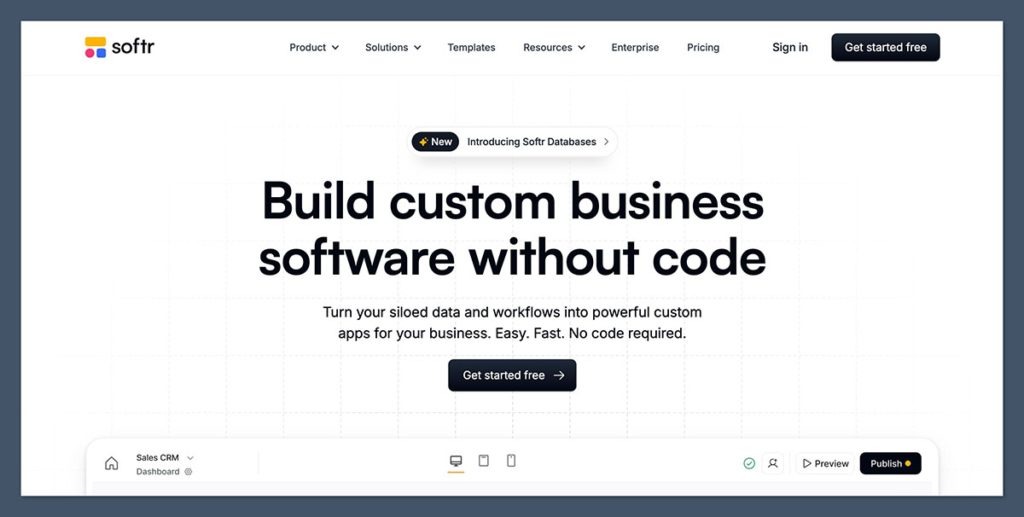
Softr turns Airtable into functional web apps, with some ecommerce capability.
It’s one of the fastest ways to launch a web app or storefront if your products live in a spreadsheet and you want to start selling — fast. The builder is visual, intuitive, and doesn’t require any coding or setup.
You simply link Airtable as your backend, drop in your content blocks, and publish.
Softr isn’t trying to be a full-blown ecommerce engine. But for creators, coaches, or small digital brands, it hits a sweet spot between simplicity and functionality — especially when you’re selling courses, downloads, or memberships.
Pros
- Super fast to build with a clean, drag-and-drop interface
- Perfect for digital goods, memberships, and gated content
- Built-in payment support through Stripe
- Native Airtable integration means your database is ready to go
- Built-in authentication, membership tiers, and dynamic content
- No-code logic for displaying content based on user roles or actions
Cons
- Not designed for physical product stores
- Limited design customisation and flexibility
- No traditional ecommerce flow (cart, shipping, tax settings)
- Not ideal for SEO-driven businesses
- Scalability is limited by Airtable’s data structure and record limits
Pricing
| Plan | Cost (USD/month) | Features Included |
|---|---|---|
| Free | $0 | Up to 200 Airtable records, Softr branding |
| Pro | $59 | 10,000 records, Stripe, custom domains, basic member features |
| Business | $167 | More records, advanced roles, priority support, SSO |
| Enterprise | Custom pricing | Custom SLAs, team features, security audits |
You’ll also need a paid Airtable plan if you’re dealing with larger datasets or want advanced database controls.
Best for
- Selling courses, digital products, templates, or gated files
- Personal brands or creators building quick, clean storefronts
- Low-tech teams wanting speed and control
- Membership sites or gated content platforms
- Service businesses that need booking, intake forms, or payment pages
Why I Recommend It
If your priority is speed, ease of updates, and low overhead — and your store doesn’t need shipping, taxes, or inventory — Softr is a great call.
Especially if you’re a solo founder, coach, or agency working with clients who want something clean and simple, not another Shopify beast to maintain.
For digital commerce, it’s hard to beat the turnaround time and control Softr gives non-developers.
How to Pick the Right Alternative
Not every tool on this list is built for the same kind of store. Some are perfect for launching in a weekend. Others are better suited for scaling to thousands of users or running custom workflows.
The trick is knowing what stage you’re at — and what you actually need.
Here’s a simple breakdown based on what you’re building:
| Your Priority | Best Options | Why They Work |
|---|---|---|
| Fast design & launch | Webflow, Framer, Softr | Drag-and-drop editors with fast publishing and simple setup |
| Ecommerce at scale | Shopify + Hydrogen, Builder.io | Performance-focused, flexible, and ready for complex workflows |
| Mobile-first selling | Thunkable, Adalo, Bravo | Native apps or app-like UX, ideal for users shopping on phones |
| Advanced logic & workflows | WeWeb + Xano | Custom logic, dynamic content, user roles, and backend flexibility |
| Simple MVPs or experiments | Glide, Softr | Spreadsheet-powered apps that launch in hours, not weeks |
Match the Tool to Your Stage
- Solo founder or creator? Focus on tools that get you live fast with low overhead — Softr, Glide, or Framer.
- Design-led brand? Webflow or Bravo gives you full control without templates.
- Serious ecommerce brand? Shopify + Hydrogen or Builder.io will let you scale and customise without rebuilding your backend.
- Need logic-heavy workflows? WeWeb with Xano is as close as you’ll get to custom software without writing code.
- Selling via mobile? Thunkable or Adalo gives you full app-building power for iOS and Android.
Final Tip
You don’t need to “learn to code” or overpay developers. You just need to pick a stack that fits your skill level, your budget, and what your store actually needs to do right now — not six months from now.
Start with the tool that gets your first sale. You can always evolve your stack later. Most of the time, momentum beats perfection.
Should You Leave Bubble?
Look, I like Bubble. It’s powerful. You can build almost anything with it — marketplaces, SaaS apps, internal tools, dashboards. But when it comes to ecommerce, there are faster and more reliable options.
If you’re trying to launch a store, not an app, Bubble can become more of a bottleneck than a solution. The flexibility is great, but that comes with complexity — and performance trade-offs.
You’re building from the ground up, which means you’re managing everything: structure, logic, design, speed, and often… bugs.
That’s fine if you’re a developer or building something truly custom. But if your goal is to move fast, make money, and avoid spending all your time in bug-fix mode, there are better tools for the job.
What Bubble Does Well
- MVPs with complex workflows
- Platforms where logic is the product (like SaaS, dashboards, marketplaces)
- Visual logic builders for non-coders who are still technically minded
- Full freedom if you’re building from a blank canvas
Where It Struggles for Ecommerce
- Page speed and performance under traffic
- Optimising for SEO and conversion
- Handling payments, checkout, and product logic natively
- Design control without layering on custom code
- Scaling without major technical overhead
So, Should You Leave It?
You don’t need to switch everything overnight. Start testing alternatives and see how they handle real-world traffic and workflows.
Here’s how I usually suggest approaching it:
- Build your next product page or sales funnel in Webflow or Framer
- Prototype your mobile experience in Adalo or Bravo
- Test out Glide or Softr if you just need a quick proof of concept
See what it’s like to manage, update, and scale. See how your customers respond. You’ll quickly know if staying with Bubble makes sense — or if it’s time to move on.
The goal isn’t to build the perfect tech stack. It’s to sell your product, grow your brand, and stay sane while doing it.
The best platform is the one that lets you move faster without constantly getting in your way.






